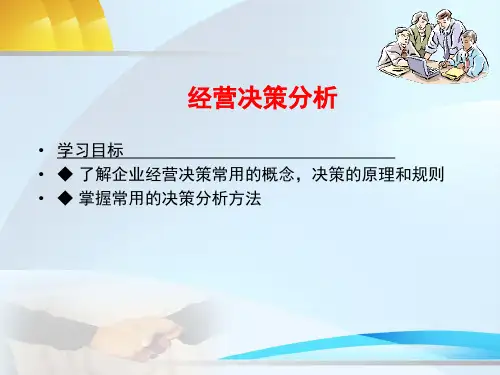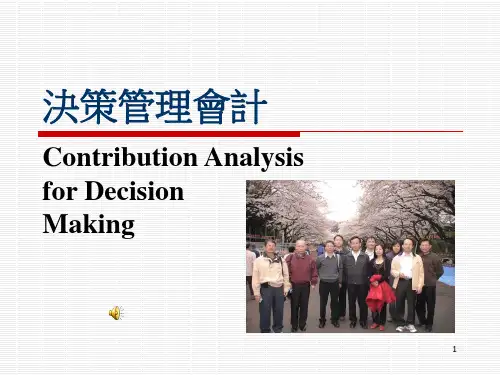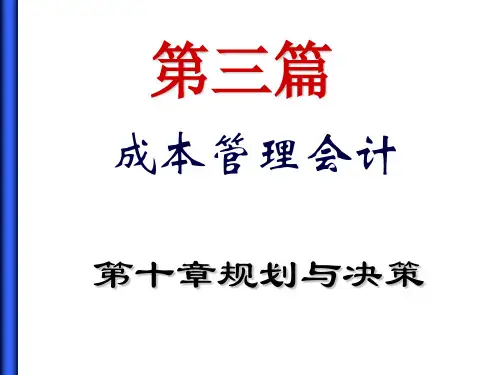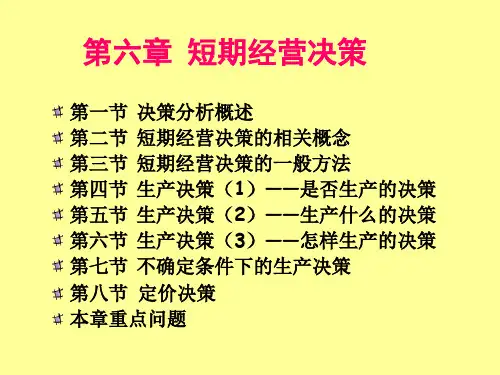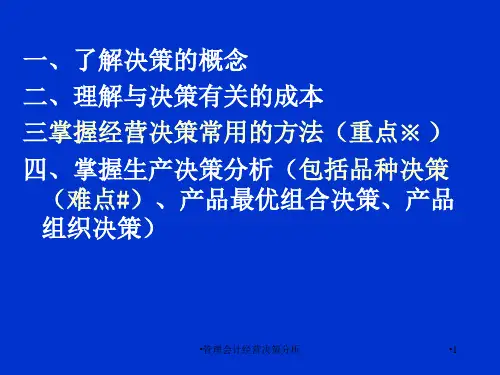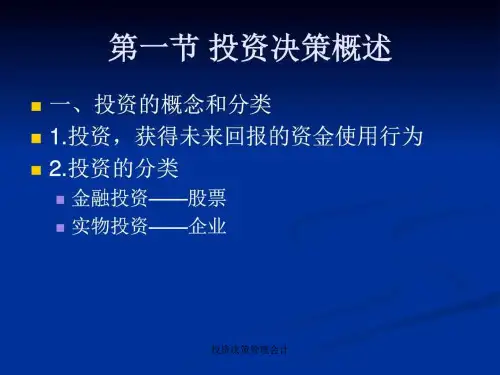- 1、下载文档前请自行甄别文档内容的完整性,平台不提供额外的编辑、内容补充、找答案等附加服务。
- 2、"仅部分预览"的文档,不可在线预览部分如存在完整性等问题,可反馈申请退款(可完整预览的文档不适用该条件!)。
- 3、如文档侵犯您的权益,请联系客服反馈,我们会尽快为您处理(人工客服工作时间:9:00-18:30)。
– Shortage of skilled labor – Shortage of materials – Lack of storage space – Lack of finance
Contribution per unit of limiting factor
• Example: the company is experiencing a shortage of skilled labor so that the company must decide which products to manufacture given the limited resources. Product A uses 1 skilled labor hour, B uses 2 skilled labor hours and C uses 5 skilled labor hours.
Contribution earned per unit
A No. of units Total revenue/cost Sales Variable costs Contribution Fixed costs Profit Unit revenue/cost Selling price Variable cost Contribution 40 20 20 50 30 20 75 50 25 200 100 100 500 300 200 300 200 100 1000 600 400 250 150 5000 B 10000 C 4000 Total
Unit values No. of units Total revenue/cost Sales £ Direct materials £ Direct labor £ Variable overhead £ Total variable costs £ Contribution £ Fixed production overhead Administration overhead Selling distribution overhead Profit 19 10 4 2 16 3 82,500
Outcome 2
Apply marginal costing techniques to
• Marginal costing is a management accounting technique, which is used to assist management in the process of short-term decision-making • Cost behavior
It’s budget information
sales Direct material costs Direct labor Variable overhead Fixed production overhead Administration overhead Selling & distribution overhead profit 750 300 150 100 40 50 1390 110 1,500
Contribution
• Contribution=Sales revenue-Variable costs • Contribution values are normally presented in a marginal cost statement .
Sales Less variable costs Equals contribution Less fixed costs Equals profit £1000 £ 600 £ 400 £ 250 £ 150
20 100000
10
200000 40000 250,000 90,000
Example-changes in prices and costs
• Detailed below is a summary of budget information for A company who manufacture and sell one product. In an effort to improve profitability you have been asked to consider two alternative courses of action:
A No. of units Total revenue/cost Sales Variable costs Contribution Fixed costs Profit Unit revenue/cost Selling price Variable cost Contribution Skilled labor hours per unit Contribution per hour 40 20 20 1 20 200 100 100 5000
B 10000
C 4000
Total
500 300 200
300 200 100
1000 600 400 250 150
50 30 20 2 10
75 50 25 5 5
A Ranking Skilled labor hours per unit (a) Demand (b) Total hours required (a×b) Limited to 33000 hours (c) 1 1 5000 5000 5000
Multi-product marginal cost statement
Product A Sales Variable costs Contribution Fixed costs Profit 200 100 100 Product B 500 300 200 Product C 300 200 100 Total 1000 600 400 240 150
Limiting factors
• A limiting factor is any restriction of resources, which prevents/limits an organization in achieving their desired result. • Examples of limiting factors may be:
Contribution Marginal cost Statement
Sales Revenue Less Variable Costs: Direct Material & labor Variable overhead Contribution Margin Less Fixed Costs: Production overhead Fixed Mktg & Admin Net Income Before Taxes $50,000 72,000 122,000 $110,000 $160,000 8,000 168,000 $232,000 $400,000
B 2 2 10000 20000 20000
C 3 5 4000 20000
total
45000
(33000- 33000 25000)= 8000 5 340,000
Contribution per hour (d) Total contribution (c×d) Fixed costs Profit
• The unit selling price is £20. please prepare a marginal cost statement for both alternatives, highlighting the impact on contribution and recommending which alternative should be accepted.
Cost Behaviour
Fixed-Cost Behaviour
$ $ Relevant Range
Variable-Cost Behaviour
Units Produced
Units Produced
Mixed-Cost Behaviour
Linearity Assumption Total Costs Cost Fixed Costs Variable Costs
• The unit value:
– 1,500,000/20=75,000units
• Variable unit costs:
– Direct material=750,000/75,000=10 – Direct labor=300,000/75,000=4 – Variable overhead=150,000/75,000=2 – Total variable cost=10+4+2=16
– Fixed costs: a cost which is unaffected by changes in output and which will be incurred even when output levels are zero.
Cost behavior
– Variable costs: A cost that varies in direct proportion to the level of activity. – Semi-variable costs: costs which neither vary in direct proportion to activity nor remain unchanged. These costs change for varying levels of activity but not in direct proportion.
Number of Units Produced
Total cost = Fixed cost + Total variable cost

